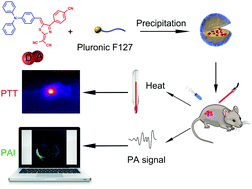2-Dicyanomethylenethiazole based NIR absorbing organic nanoparticles for photothermal therapy and photoacoustic imaging†
Abstract
A near-infrared absorbing chromophore has broad prospects as a photoacoustic imaging/photothermal agent due to its simple chemical structure, high purity and good biocompatibility. But its development is severely limited due to low photothermal conversion efficiency and photothermal instability. Hence, a donor–acceptor chromophore containing 2-dicyanomethylenethiazole as an electron acceptor and triphenylamine as an electron donor is synthesized, and encapsulated in Pluronic F127 to fabricate organic nanoparticles for PA imaging and PTT application. The yielded organic nanoparticles possess near infrared absorption, high photostability, good biocompatibility, and high photothermal conversion efficiency (38%). In vitro and in vivo experiments demonstrated that organic nanoparticles show good performances in PA imaging and photothermal ablation of tumors, and are candidates for PAI/PTT agents.



 Please wait while we load your content...
Please wait while we load your content...